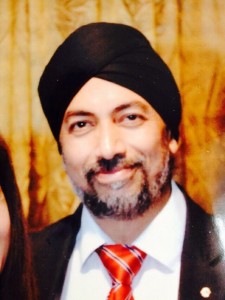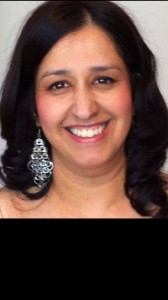By Ashlee Roberts
For many years, the shortage of stem cell/bone marrow donations from the Asian community has had a devastating effect on the survival rates of blood cancer victims. Two cancer sufferers, Raj Singh Bhuller and Sarbjit Matharu are in need of urgent stem cell donations. Their families have started campaigns across the country and abroad to help save their loved ones and help others who are suffering from cancer. With the help of the Delete Blood Cancer Charity; they are fighting to change the statistic of ethnic minority communities abstaining from donating. We had the honour of interviewing Mukhjinder Singh from the Raj Singh Bhuller family, Kam Arora from the Sarbjit Matharu family and the Delete Blood Cancer Charity to find out how they are trying to save lives.
 What was your initial reaction when you found out Raj and Sarbjit was ill?
What was your initial reaction when you found out Raj and Sarbjit was ill?
Mukhjinder: Devastated. Words couldn’t describe the feeling – I didn’t know what it meant or entailed. It wasn’t until I realised that Raj was getting Chemotherapy that I understood what he had: he was diagnosed with Blood cancer.
Kam: I think it was a case of shock. We haven’t got a history of cancer in our family. It just turned our world upside down. We felt like we had been hit by a bus. We didn’t know what to expect out of it or how to cope with it in the initial stages.
What symptoms did Raj and Sarbjit show that led them to get an appointment with a doctor?
Mukhjinder: Three weeks before diagnosis he was suffering from severe stomach problems. He went to the doctor and he was given something to relieve his pain but then it came back. He also suffered from a temperature and really bad night sweats. The doctor was really concerned so he sent Raj for a full blood test. The very next day he got a call from the doctor asking him to come into A&E and someone will see you – within twenty minutes of being at the hospital, he was told he had leukaemia. I think they knew the patterns and signs in his symptoms.
Kam: She was ill for about a year. She had a lot of stomach pains. She was treated for something called H. Pylori. The doctors assumed it was a continuation of the condition, but when she eventually changed GPs: her blood results were suspicious. She lost an awful amount of weight. It got to the point where she couldn’t even sit in a chair without collapsing. It made her really weak.
 For years, the number of people being diagnosed with cancer has increased, which has led to a lot of people donating stem cells and blood samples for bone marrow matches, however in the Asian and Black communities the number of people donating is very low. What do you think the reason for this is? Do you think the Asian community aren’t listening to the problem?
For years, the number of people being diagnosed with cancer has increased, which has led to a lot of people donating stem cells and blood samples for bone marrow matches, however in the Asian and Black communities the number of people donating is very low. What do you think the reason for this is? Do you think the Asian community aren’t listening to the problem?
Mukhjinder: I believe a lot of our community aren’t aware of it. If you are Caucasian, the chances of finding a match are 90%, but if you’re black and Asian, the chances drop to 40%. They probably don’t know anything about it. I was like them, but this touched my life. It’s a very real problem that surrounds us all. People need to realise that they can save lives.
Kam: People need educating. I think peoples interpretation of a bone marrow transplant or what it was originally known as was quite an intrusive procedure. People were just frightened. When we do our donor drives; a lot of people think the procedure is going to be painful, but when we actually tell people that all you have to do is give blood and they take the stem cells out of your blood, people are more willing to give. It’s just about changing that image of the old ways.
Despite everything, you and your family have not given up hope, which led to the start of the Raj Singh Bhuller Campaign. How did it get started?
Mukhjinder: On the 15th January, my brother was given more bad news that his chemotherapy was not enough to cure him. He was going to need stem cells. Myself and my sister was tested but we were not a match. That’s when we realised that we need to find another donor. My cousin’s children, Jazmine and Puneet, were more aware of this, and started the campaign to raise more awareness in ethnic minority communities to encourage them to register. It has to be in our own ethnic type for the stem cells to be a match. I think from then on we spent every weekend to get more people on the register.
Kam: We were approached by the Raj Singh Bhuller campaign. They had been doing drives for some time. They said they were happy for us to join their campaign. We’re all part of the same cause – one team one dream. It’s not about who can get the most people on the register it’s about working together to achieve our goal.
Do you feel as if the campaigns has been a success?
Mukhjinder I think it’s a success in the fact we have over three thousand, five hundred people registered since January 2015. This could save anybody’s life, we just don’t know who – it could even be the future generations. These days you hear about 1 in 2 people are diagnosed with cancer, we want to help those affected.
Have you received any help from cancer charities?
We have been in partnership with Delete Blood Cancer UK. They have been helping us campaign by coming to events offering help and advice to others who are in the same situation as us.
Do you think they should teach more about leukaemia and other cancers in schools?
Mukhjinder: I think it would be very useful. Teaching about cancer from a young age might encourage the next generation to donate more than ours does. We have to educate them to save lives.
Kam: I definitely think it should be done. I qualified as a teacher and I’m aware of the enrichment lessons that happen in school. I think it would be an incredible way of getting these children aware of the problem. A lot of children would have come across members of their family with cancer, so it would be great if I could set up something that allows me to go into schools and promotes the cause to children of a secondary school age, making them aware as early as possible. It would be nice to also target college students as well as they are already at an age where you can sign up.
What advice would you give to someone who has found themselves in your situation? How would you advise them to stay strong?
Mukhjinder: (Laughs) I wouldn’t say I’m very strong but I would tell them not to give up hope because it is a curable disease. My faith in God has been a great comfort to me; I believe my strength has come from him. I know he will get my brother through this. Our family is strong and we lean on each other. You have to be strong for them.
Kam: When something like this hits your family, your emotions are all over the place – that is going to be unavoidable, but you have to accept what it is. The sufferer may not want to talk about it with their family. It could be a way of them trying to protect their family from the emotional pain. It could also be the case that the family might be scared to bring up the topic, but as longs as someone is there to listen to you then you will come to terms with the situation. The family has to learn to stay strong, and realise that it can be beaten. Positive thinking is the key.
What’s next for the Raj Singh Bhuller Campaign?
Mukhjinder: We have an event coming up at a Vaisakhi festival. It is estimated there is going to be around 50,000 people there. We’re going to try to get as many people as possible to sign up. We’re hearing more and more people say they are registered. It’s such a good feeling. We are going to try to educate as many ethnic minorities as possible. Raj and his wife were registered before this happened. They were willing to help, and hopefully someone will be willing to help us. We will find a match.
Kam: I think the next thing is to continue to with the campaigns. We have been heavily targeting the Asian community but I believe we need to start helping the afro Caribbean community as well. We need to start targeting schools and universities. In most universities they have what is called “marrow societies”, I’m not sure how active they are but it could be a case that they don’t have the numbers or they need help in campaigns. There’s a lot to be done. We still need to find a match for my sister, but in my husband’s GP practise, we are going to offer the option to register when people sign up to our practise, in an attempt to try to recruit more people. The more lives we can save, the better.
Delete Blood Cancer
How would you describe Delete blood cancer to our readers?
We have been operating in the UK for about two years. We do one thing – we register blood stem cell donors. This means they would be on standby to donate stem cells if their donation was a match. We try to help anyone who has an illness that requires blood stem cells
How have you helped the Raj Singh Bhuller and the Sarbjit Matharu Campaigns?
We run appeals for them to try to help them find donors and a potential match. We have been targeting the South Asian community, there are far less people from that community than in the Caucasian community. By focusing on that community it will increase the chances of finding a match for someone from the Asian community to help them get better.
3) Why do the Black and Asian communities have a lack of donations?
They are donating, it’s just that the communities are smaller. It’s harder to find a matching donor in ethnic groups than in Caucasian so we need a lot more samples to test in order to find a match. At the moment, far too many aren’t finding the matches that they need.
A lot of people are familiar with donating organs but not a lot of people are familiar with donating blood stem cells. They might not be aware of how easy it is to donate or how important it is to find a matching blood type. We need to save as many people as possible. You could be that one person who can save a life.
What advice would you give for the family of the sufferer?
Stay hopeful. Many matching donors are found. It can be treated. Be very united with others in the same boat and share your experience. Focus your mind on trying to find a matching donors. The families of Raj Singh Bhuller and Sarbjit Matharu have been incredibly inspiring for other families and to us as a charity.
What is the process of donating and finding a match?
The process is called Peripheral Blood Stem Cell – it’s very easy. People often read books and listen to music whilst doing it. You’re awake and it probably takes about three hours. 10% of the time it’s done under a general anaesthetic. They use a needle in the back of the hip bone. This is usually for cases where children are involved. People say that at worst it feels like you’ve taken part in a tough rugby match.
In three words describe your job
(Laughs) Emotional, inspiring and unexpected – every day there’s someone new to help.
We are happy to announce that since this interview, Raj Singh Bhuller has found a match! His family’s tireless efforts to save their loved one has been successful, and hopefully Sarbjit will find a match soon.





















